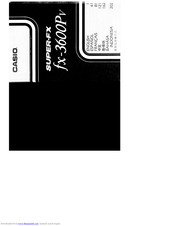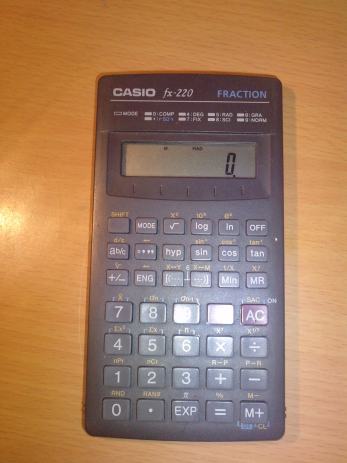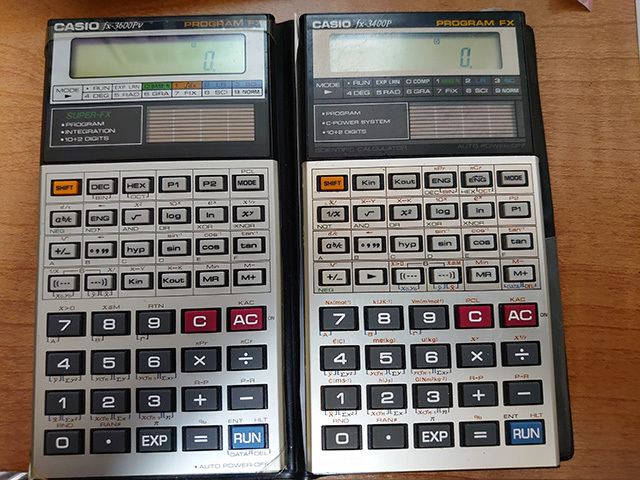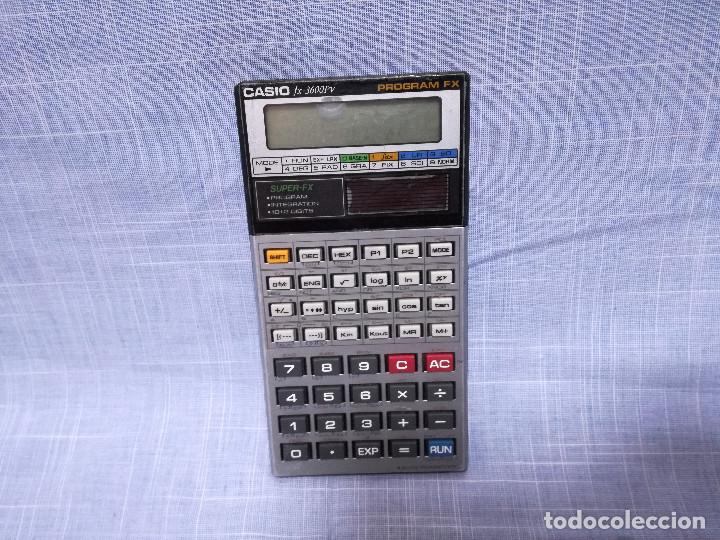Moreover, CASIO Computer Co., Ltd. Shall not be liable for any claim of any kind whatsoever by any other party arising out of the use of this product and the items that come with it. Be sure to keep all user documentation handy for future reference. Sample Operations Sample operations in this manual are indicated by a icon. View the manual for the Casio FX-350MS here, for free. This manual comes under the category Calculators and has been rated by 14 people with an average of a 9. This manual is available in the following languages: Engels. We recommend that you download the large PDF files that are available from this site and view them off-line. To view the contents of a file. CASIO fx-3600Pv Manuals You can select the degree of the polynomial 2 or 3 or press again the right pointing arrow to select the number of unknowns for simultaneous linear equations 2 or 3. You can’t post conmments that contain an email address. We recommend that you download the large PDF files that are available from this site and view them off-line. To view the contents of a file.
CASIO fx-3600P scientific calculator from 1985 |
Post: #1 |
| CASIO fx-3600P scientific calculator from 1985 This specimen remained for almost a year for sell at a local auction site. Jose MesquitaFinally I decided to acquired it, for the principesca amount of 15 Euro. It was made in Japan after 1985, according to the Hitachi HD43147 SoC processor date code. Casio fx-3600P calculator forensics: arcsin(arccos(arctan(tan(cos(sin(9)))))) = 9.0000157179 Tested in DEG mode. Typed: 9 sin cos tan INV tan INV cos INV sin Result1: 9.000015718 Typed: - 9 = Result2: 1.57179 -05 Typed: x 1000000 = Result3: 15.7179 Note the 'Lithium' label printed at the bottom left side of the display bezel. I believe it relates to the case silver color, although the CR2025 power cell also contains Lithium. Front panel was kind of lose, due to the adhesive film dried glue. As usual with CASIO machines, opening the case is extremely easy. The back cover is fixed with four screws that, once removed, allows the cover to slide and lift. It uses a single 3 Volt CR2025 Lithium battery cell. The power consumption is 0.430 mW (average current of 0.14 mA) Two classic axial pass through mount 1/8 Watt 5% resistors on the PCB back side. Top = 390 Ohm, Bottom = 220KOhm PCB front side. Keyboard assembly (foil membrane attached to the PCB). One unmarked SMD ceramic capacitor at top left side. And the Hitachi HD43147 SoC processor, made in 1985 week 43 (5J 43). Keyboard rubber membrane. Real quality plastic keys, sporting injection molding manufacturing. These keys don't 'click' to give a mechanical feedback, but they register successfully on every single key stroke after so many years of usage. And when they fail to register, a easy cleaning is all it takes to restore normal operation. Partial exploded view. RadioMuseum.org member |
Post: #2 |
| RE: CASIO fx-3600P scientific calculator from 1985 Hi, jebem! During a few years I used fx-3600pv, and then it was given as a gift for somebody, because this calculator is very primitive for me. What exactly attracted You in it except a price? I sometimes buy old beautiful garbage (МК- 61,52, fx - 6300g etc.) as remembrance about kind old times. |

Post: #3 |
RE: CASIO fx-3600P scientific calculator from 1985 (11-17-2015 07:06 PM)Hlib Wrote: Hi, jebem! Hello, Hlib, Yes, we have this engineering/science thing inside us that force me to acquire stuff from time to time just for fun! From what I see from some of your posts, probably you also are in the same route, no? I am in a phase of collecting machines from when I was a teenager! So, I am buying pocket transistor and small valve radios and calculators mainly from the 70's and 80's. My first calculator at electronics technical school was a CASIO fx-21, and when I stared working I got a HP-55, a HP-67 and a HP-25C. My first contact with Russian technology (Professional radio transmitters, radar, consumer receivers and calculators) was in 1975 in Mozambique, when CCCP went there for cooperation. I was living there at the time, and I have worked with the Soviets for about 4 years, before returning to Europe. My electronics background 'invites' me to have some strange hobbies for a lot of ordinary people... Check this valve class A stereo amplifier that I have built in the early 80's (sorry, the site is written in Portuguese). I spent a small fortune acquiring these high quality expensive high voltage components, but the sound is amazing if one enjoy high fidelity. And above all, I had real fun and very good time designing and building it! RadioMuseum.org member |
Post: #4 |
RE: CASIO fx-3600P scientific calculator from 1985 (11-17-2015 08:10 PM)jebem Wrote: Hello, Hlib, Yes, I too from that epoch. Portable radio receiver from 'Hitachi' 60th, radio-cassette 'Sanyo', transistor amplifier 'Schneider' and many other real things from 70-80th for me remain the standard of technical idea. Old calculators also are part of my life, but not all from them were good calculators, and it is a fact. Your materials are always very interesting for us. I hope, you will continue this work. |
Post: #5 |
RE: CASIO fx-3600P scientific calculator from 1985 (11-17-2015 04:46 PM)jebem Wrote: Note the 'Lithium' label printed at the bottom left side of the display bezel.Back then it wasn't uncommon to use the Lithium label as indication for long runtimes. My first LCD-watch also carried it. |
Post: #6 |
| RE: CASIO fx-3600P scientific calculator from 1985 I bought this calculator new for around £22 and still use it today. The Lithium refers to the Lithium battery which was a relatively new innovation at that time when most other calculators were using AA or AAA Alkaline batteries. I have occasionally had to clean the PCB button contacts with IPA to restore button key press sensitivity. |

Post: #7 |
| RE: CASIO fx-3600P scientific calculator from 1985 Little off, this is a 3600PV - but check the picture at the end of the blog. If a Chinese is surprised that it is being falsified, then the world is over. CASIO FX-3600PV - or something else?!?? Csaba |

Post: #8 |
RE: CASIO fx-3600P scientific calculator from 1985 (05-22-2018 07:44 AM)Csaba Tizedes Wrote: Little off, this is a 3600PV - but check the picture at the end of the blog. I love knock-offs and collect all I can! I'd buy the Catiga if it was available here. Cui bono? |
Post: #9 |
RE: CASIO fx-3600P scientific calculator from 1985 (02-02-2017 12:34 PM)boeman Wrote: I have occasionally had to clean the PCB button contacts with IPA to restore button key press sensitivity. How does India Pale Ale (IPA) fix it? Cui bono? |
Post: #10 |
RE: CASIO fx-3600P scientific calculator from 1985 (05-22-2018 09:49 AM)toml_12953 Wrote:(02-02-2017 12:34 PM)boeman Wrote: I have occasionally had to clean the PCB button contacts with IPA to restore button key press sensitivity. ok, I know you are making a joke, but here is what IPA means in the context of what we do to repair/clean these calculators, to the benefit of other members unfamiliar with it: IPA = Isopropyl alcohol RadioMuseum.org member |
Post: #11 |
RE: CASIO fx-3600P scientific calculator from 1985 (05-22-2018 09:49 AM)toml_12953 Wrote: How does India Pale Ale (IPA) fix it? Baltika is my current preferred cleaning system RadioMuseum.org member |
Post: #12 |
RE: CASIO fx-3600P scientific calculator from 1985 (05-22-2018 01:53 PM)jebem Wrote:(05-22-2018 09:49 AM)toml_12953 Wrote: How does India Pale Ale (IPA) fix it? Это звучит хорошо для меня! Cui bono? |
Post: #13 |
RE: CASIO fx-3600P scientific calculator from 1985 (05-22-2018 06:41 PM)toml_12953 Wrote:(05-22-2018 01:53 PM)jebem Wrote: Baltika is my current preferred cleaning system We have one Mix Markt russian store in Lisbon. They are popular around Europe. Despite many of the canned products are manufactured in Germany, they use traditional Russian recipes. However one of the top class products are the Baltika genuine beverages. RadioMuseum.org member |
Post: #14 |
| RE: CASIO fx-3600P scientific calculator from 1985 Is it possible to speed-up the fx-3600P (or any CASIO fx from this 80's era)? Have you got a link about how is it can be done? As I can remember there was a detailed text about the 12C/15C speed-up, I think this is totally same. Please check the 180P PCB here: (link to picture) - maybe this condensator same? Thanks for the answers! Csaba |
Post: #15 |
| RE: CASIO fx-3600P scientific calculator from 1985 It is possible to overclock these Casio calculator series, but results are not guaranteed. Jose MesquitaI didn't try on this particular model, but similar models responds well to overclocking, despite consuming more battery current. These SoC (system on a Chip) calculators have the oscillator embedded in the chip but usually the operating frequency is set by a single external resistor of usually high value (in the order dozens to hundreds of kilo-ohms). So, no capacitors, inductors or resonators/crystals are used here to set the oscillator frequency, unlike seen on some other Casio models. In this model in particular there are only two components to change and test: - The 220KOhm resistor (most probable component controlling the oscillator frequency); - The unmarked SMD capacitor (not probable at all, but who knows, testing is required). Pictures showing these components are available at my first post. To do this modification, a basic oscilloscope and a current meter in the micro-amp range would be the minimum tools to start changing the oscillator frequency. A frequency meter of some sort would be useful too. Changing the components in the blind is not recommended, as the results can be unstable (due to excessive oscillator waveform distortion), or else it will consume excessive current depleting the batteries at a fast rate. Concerning large capacitance capacitors often seen inside calculators, like electrolytic and tantalum types that also are typically big in physical terms when compared to the other components around), these are used as by-pass/filtering for power supply filtering purposes. RadioMuseum.org member |
05-29-2018, 05:16 PM (This post was last modified: 05-29-2018 08:31 PM by Csaba Tizedes.) |
RE: CASIO fx-3600P scientific calculator from 1985 (05-29-2018 12:15 PM)jebem Wrote: It is possible to overclock these Casio calculator series. To do this modification, a basic oscilloscope and a current meter in the micro-amp range would be the minimum tools to start changing the oscillator frequency. Or I just try to figure out how changes the speed of a running program if I modify values of these elements. I am not sure how the resistor is set the frequency itself. This resistor and capacitor works like an oscillator? As I can remember (and Googled) this system is not oscillating - or may I am wrong? Thanks for any hints! Csaba |
Post: #17 |
RE: CASIO fx-3600P scientific calculator from 1985 (05-29-2018 05:16 PM)Csaba Tizedes Wrote: I am not sure how the resistor is set the frequency itself. This resistor and capacitor works like an oscillator? As I can remember (and Googled) this system is not oscillating Sure it works as an oscillator. Look for 'RC oscillator' in google. There are several RC Oscillator variants, from a basic single transistor feedback loop, to more sophisticated operational amplifier designs, or even a astable flip-flop design. In many of these basic calculator designs using just one chip, it is common to have the capacitor integrated inside the chip. This capacitor capacitance is usually very small, in the order if hundreds ot pF only, therefore the resistor value must be in the order of several hundreds kiloohms to achieve the nominal low oscillator frequency.. These Casio series runs at frequencies around 400 to 800 KHz only. These machines are slow and in this way they save the battery that will last years. The lower the resistor, the higher the frequency will be. However the rc oscillator will not work with any range of resistor values and tbat is why there is the need to try and test. RadioMuseum.org member |

Post: #18 |
RE: CASIO fx-3600P scientific calculator from 1985 (05-30-2018 08:31 AM)jebem Wrote: Sure it works as an oscillator. OK, as I can understand, the frequency is depends on the reciprocal of the resistor value: f~1/R. Meantime I tried to find a calculator which I can dismantle and I think I will try it on a 3400P if it has same resistor inside or I have one workable but not so good shaped CASIO fx-6300G. If inside I found a crystal oscillator, can I try to change it? |
Post: #19 |
RE: CASIO fx-3600P scientific calculator from 1985 (05-31-2018 05:47 PM)Csaba Tizedes Wrote: OK, as I can understand, the frequency is depends on the reciprocal of the resistor value: f~1/R. That is my understanding too, but the actual formula will depend on the R*C time constant plus additional constants and operators, depending on the oscillator circuit in use. Because the oscillator is internal to the chip, there is on way to know in advance what exact formula to use. That is why people playing with this subject of overclocking use the experimental method and sometimes one can guess the actual formula from the test results and even guess the internal oscillator circuit in use. To summarize, the lower the R*C time constant, the lower the oscillator period and higher the frequency. (05-31-2018 05:47 PM)Csaba Tizedes Wrote: Meantime I tried to find a calculator which I can dismantle and I think I will try it on a 3400P if it has same resistor inside or I have one workable but not so good shaped CASIO fx-6300G. If inside I found a crystal oscillator, can I try to change it? To be honest, I am not a adept of overclocking anything anymore (those days are gone for me), although I enjoy to see other people fiddling with it. Concerning the 6300G: Yes, I vaguely remember to see a resonator/crystal inside one of my 6300G machines and this would give a more precise oscillator frequency useful to operate the graphical LCD properly. Another resonator could be used, but this may cause issues on the LCD operation. As I said before, one would need to experiment. It is a try and error job. As for the 3400P/3600P: I do not have the 3400P in my collection, but being a low end series like the 3600P, my guess is that you may find a couple of resistors and a capacitor inside as well. The low value resistor is usually used to limit the current consumption of the calculator and should not change the oscillator frequency. The high value resistor (above 100Kohm typically) is the one to check. There is no need to remove the resistor. Just solder another resistor in parallel. Concerning the additional resistor value to use: It is a test and try job. - The starting point would be around the same value as the one installed from factory, giving a final resistance value of half of the original value. - Depending on the test results, other resistor values could be tested. If the machine hangs, use a resistor with at least two to four times the original value and try again. If it works, use lower values until it stops working. The capacitor, if it is a low value (in the range of 20 to 200pF) could be a candidate to check too, but usually this single capacitor is there to bypass/filter the power supply, so it is not a first option to try. That said, a visual inspection and a multi-meter will help here: if it is connected to the power supply lines, it is not part of the R*C constant. And if it is really part of the R*C constant, here you would need to remove the capacitor and install a new one with a lower capacitance value (unlike resistors, putting two capacitors in parallel will add to the capacitance value). RadioMuseum.org member |
Post: #20 |
RE: CASIO fx-3600P scientific calculator from 1985 (05-31-2018 05:47 PM)Csaba Tizedes Wrote: I have one workable but not so good shaped CASIO fx-6300G. If inside I found a crystal oscillator, can I try to change it? I've overclocked my FX-6300G from 0.8 to 2.6 MHz many years ago and it still works flawlessly. In the case of the FX-6300G, you only need to change the resonator. |
« Next Oldest | Next Newest » |

User(s) browsing this thread: 1 Guest(s)
Casio Fx-3600pv Manual
Casio fx-3600Pv
| Datasheet legend Ab/c: Fractions calculation AC: Alternating current BaseN: Number base calculations Card: Magnetic card storage Cmem: Continuous memory Cond: Conditional execution Const: Scientific constants Cplx: Complex number arithmetic DC: Direct current Eqlib: Equation library Exp: Exponential/logarithmic functions Fin: Financial functions Grph: Graphing capability Hyp: Hyperbolic functions Ind: Indirect addressing Intg: Numerical integration Jump: Unconditional jump (GOTO) Lbl: Program labels LCD: Liquid Crystal Display LED: Light-Emitting Diode Li-ion: Lithium-ion rechargeable battery Lreg: Linear regression (2-variable statistics) mA: Milliamperes of current Mtrx: Matrix support NiCd: Nickel-Cadmium rechargeable battery NiMH: Nickel-metal-hydrite rechargeable battery Prnt: Printer RTC: Real-time clock Sdev: Standard deviation (1-variable statistics) Solv: Equation solver Subr: Subroutine call capability Symb: Symbolic computing Tape: Magnetic tape storage Trig: Trigonometric functions Units: Unit conversions VAC: Volts AC VDC: Volts DC |
|
An interesting modern variant of Casio's venerable low-end programmable scientific calculator series, the fx-3600Pv also happens to be a machine with a curious bug, a bug not present in its predecessor, the fx-3600P. I encountered this as I was trying to create a program to compute the Gamma function, which of course is my favorite programming example for calculators. Take a look at this simple program:
Casio Fx 3600pv User Manual
This program should compute the logarithm of the products of numbers starting from the number in the display, up to and including the number in the calculator's independent memory. For instance, if the number on the display is 5, and the number in memory is 9, running this program should produce 9.62377..., i.e., the natural logarithm of 15120 (=5×6×7×8×9). What it does compute instead is something completely different: 13.57639..., which is the logarithm of 787320. It took me some time to figure out this riddle: 787320=9×18×27×36×5! I.e., while we're decrementing the single-digit argument in the display register, a phantom digit in the second position appears in the multiplication. The same effect is not reproduced if you perform this calculation by hand; nor is this effect present if the independent memory contains a number greater than, or equal to, 10.
Oh well, scratch one useful method for shortening my Gamma function program. Here is a program anyway, one that performs a somewhat lengthier calculation but avoids this bug.



